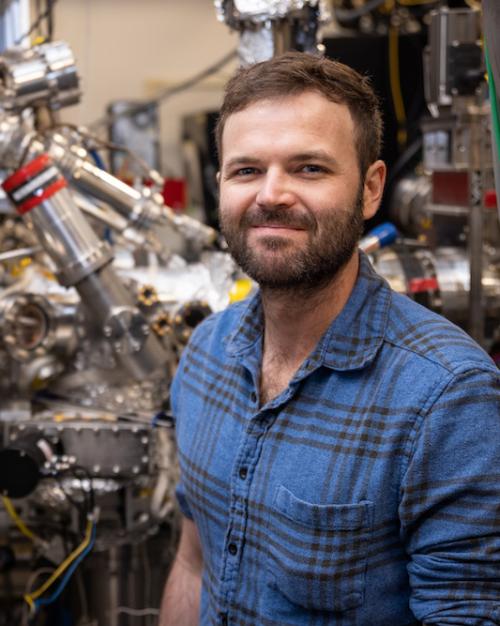Imagine a patch of material an inch across – wide enough to handle – but only one atomic layer thick.
“It’s a simple concept, really,” said Paul Malinowski, a Klarman Fellow in physics in the College of Arts and Sciences. “You pull on it.”
Applying strain to atomically thin sheets of iron-based superconductors he synthesizes in the lab is one technique Malinowski is attempting to use to study the complex world of electron behavior in quantum materials. It’s simple in concept but complex in practice.
“We physicists understand really well the laws that govern quantum mechanics – how electrons and other fundamental particles behave,” Malinowski said. “But when they are in the solid state, there are an enormous number of these particles – 10 to the power of 23 – all interacting together. The same underlying laws of physics give rise to a wide range of different collective phenomena that impart novel and interesting microscopic properties to the material: things like superconductivity, or complicated forms of magnetism, or even more exotic phases.”
Malinowski came to Cornell to conduct quantum material research, joining a high concentration of leading quantum researchers working together through an initiative for interdisciplinary research in the quantum realm.
“Paul is a world expert at using mechanical strain to precisely manipulate the properties of materials, for instance, applying a small force to turn superconductivity ‘on’ and ‘off’ in a certain class of iron-based superconductors,” said Kyle Shen, the James A. Weeks Professor of Physical Sciences in physics and Malinowski’s faculty host. Shen is also director of the Laboratory of Atomic and Solid State Physics and a Stephen H. Weiss Presidential Fellow. “We are hoping to apply the tools and techniques that Paul pioneered during his Ph.D. research [at the University of Washington] to a broader class of materials that we synthesize and study at Cornell.”
The study of quantum materials is like studying the sociology of electrons, Malinowski said; in the same way a complex human society emerges from interactions between individual people, complex behaviors emerge from a material as a result of individual electrons interacting within the solid state.
Malinowski is particularly interested in superconductors: materials in which the electrons perfectly flow through the material without dissipating any energy. High temperature superconductors have the most potential utility, but are also the least understood, he said.
“We’ve been studying these for 40 years and still have fundamental questions,” said Malinowski, who focuses on iron-based superconductors. “They have a lot of intertwined quantum phases where it’s not just superconductivity; there’s magnetism and other forms of these quantum phases. It’s an extremely complicated system.”
Malinowski’s research involves first making these materials. Since arriving at Cornell in July, he’s learned molecular beam epitaxy (MBE), which is like atomic spray painting, he said. Researchers direct a spray of atoms of a particular element toward a substrate, controlling variables like temperature and pressure to encourage a very precise crystal growth as thin as a single atomic layer.
In a similar technique, remote epitaxy, the researchers place a layer of graphene – a single atomic layer of carbon – on the substrate before growing the crystal on top of the graphene. The graphene weakens the bonds holding the material to the substrate, allowing the researchers to peel the material off the substrate.
“The resulting free-standing atomically thin membrane of a particular quantum material dramatically increases our ability to tune the properties,” Malinowski said.
Manipulating the properties of atomic material helps Malinowski understand the fundamental physics of how different quantum phases develop and are related to each other. He also wants to tune them to harness and control their properties on-demand.
Although there are a variety of ways to tune a quantum material, including manipulating the chemical makeup, applying external forces such as a magnetic field, applying pressure or changing the temperature, Malinowski focuses on strain – pulling on those sheets of material.
“Iron-based superconductors are very sensitive to strain, so it’s a natural tuning parameter for this family of materials,” he said. “Strain is a powerful tuning parameter because it directly alters the crystalline environment at the atomic scale. You’re changing the symmetry the electrons are seeing as they fly around. You’re changing the energy scales and interaction strengths. Any little change in some microscopic parameter could potentially have drastic effects on material properties, such as switching between metallic, insulating or superconducting behaviors.”
In principle, strain could be used to study a wide variety of quantum materials. Eventually, Malinowski and colleagues hope they can use the technique to control quantum phases, turning them on and off like a switch.
“Paul brings a lot of knowledge and expertise that’s entirely new to Cornell,” Shen said.
While Cornell’s quantum ecosystem keeps Malinowski focused on his research, the collegiality of the Klarman Fellowships program, which is open to extraordinary early-career researchers in sciences, social sciences and humanities, helps him balance: “The diversity of people working in the program, the exposure to fields I didn’t know that scholars work on, that’s my favorite part about it.”







